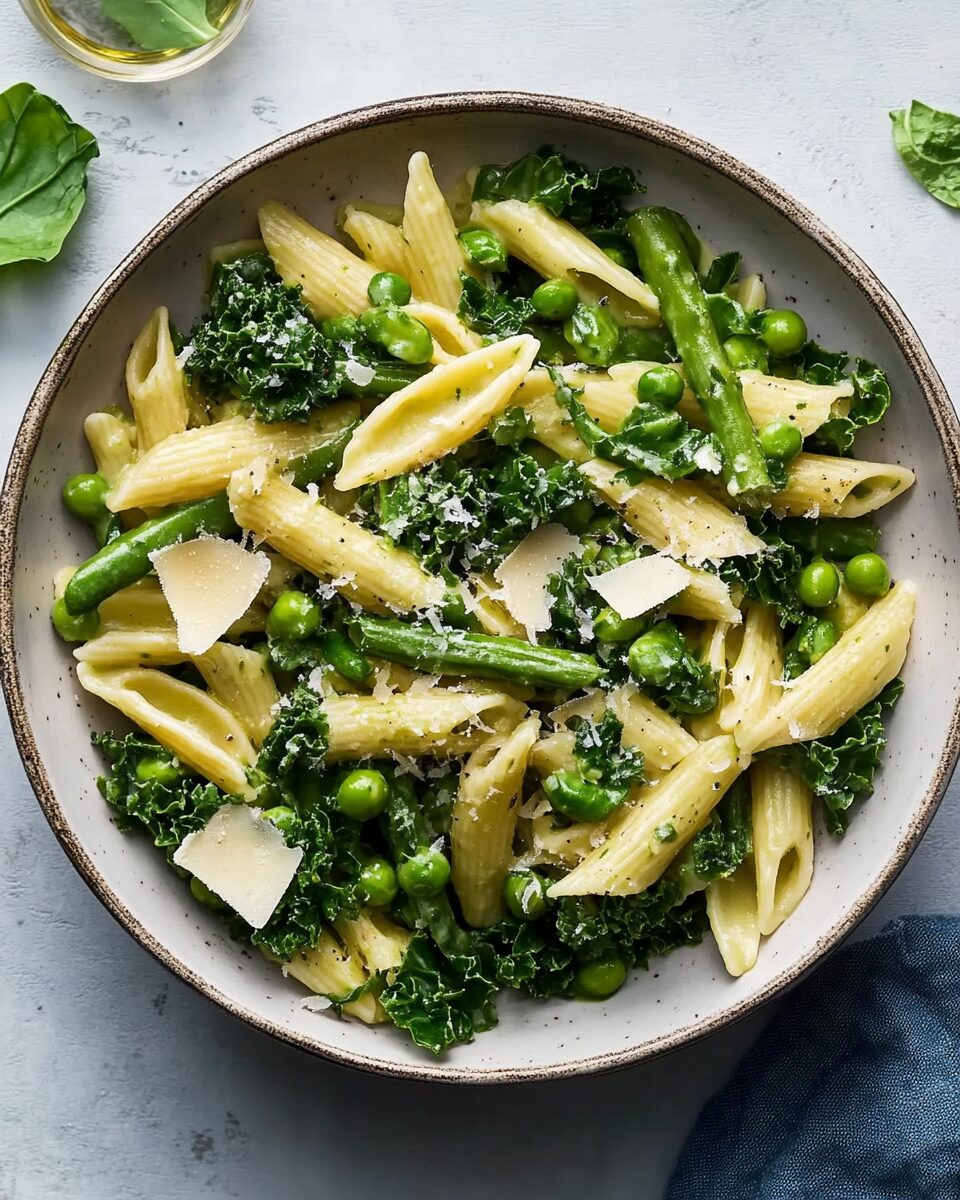The essence of spring comes alive in this bright and herbaceous Pasta Primavera. Featuring the crisp sweetness of snap peas, tender asparagus tips, and hearty kale ribbons, this dish is tied together with a luscious lemon-chive purée that coats every bite with a tangy, fresh flair.
Perfect for a weeknight dinner or a sunny brunch, this recipe is a celebration of seasonal produce and Italian simplicity. It’s vegetarian, vibrant, and endlessly satisfying—comfort food without the heaviness, and a perfect way to eat green while keeping it gourmet.
Full Recipe:
Kosher salt
8 ounces penne pasta
8 ounces snap peas, trimmed and halved crosswise
1 bunch thin asparagus, trimmed and cut into 1 1/2-inch pieces
1 small bunch Tuscan kale, stems removed and leaves roughly chopped
1/3 cup extra-virgin olive oil, plus more for drizzling
1 large bunch fresh chives, chopped
Zest of 1 lemon and 1 tablespoon lemon juice
Freshly ground black pepper
1 tablespoon chopped fresh tarragon
1/4 cup coarsely grated pecorino romano or parmesan cheese
Directions:
Bring a large pot of salted water to a boil. Add penne and cook as directed.
During the final 3 minutes of cooking, stir in snap peas, asparagus, and kale.
Reserve 1/2 cup of pasta water. Drain pasta and vegetables.
In a blender, combine olive oil, all but 2 tbsp of chives, lemon zest and juice, 1 tsp salt, a few grinds of pepper, and 3 tbsp cold water. Blend until smooth.
Transfer the chive purée to a large bowl. Stir in tarragon and a drizzle of olive oil.
Toss in pasta and vegetables, 1/4 cup reserved water, and half the cheese. Mix well to coat.
Adjust seasoning and loosen with more pasta water if needed. Top with remaining cheese and chives before serving.
Prep Time: 20 minutes | Cooking Time: 15 minutes | Total Time: 35 minutes
Kcal: ~480 kcal | Servings: 4 servings
A Celebration of Spring on a Plate
Pasta Primavera has long been a hallmark of Italian-American cuisine, symbolizing the arrival of spring and the freshness it brings. The version featuring peas, asparagus, and kale elevates the classic dish by highlighting three powerhouse vegetables known for their color, texture, and nutritional value. It’s not just a meal—it’s a tribute to the season.
This dish masterfully blends tender penne pasta with the bright crunch of snap peas, the earthy elegance of asparagus, and the robust texture of kale. Balanced with a zesty lemon-chive dressing and a touch of cheese, it’s the kind of light yet satisfying dish that feels both wholesome and indulgent.
The Origins of Pasta Primavera
Though Pasta Primavera has the ring of a traditional Italian dish, its origins are actually rooted in North America. The dish came into popularity during the 1970s, reportedly invented by Sirio Maccioni, owner of New York’s Le Cirque restaurant. It quickly became a trend, capturing the imagination of home cooks and restaurant chefs alike. The name “Primavera,” meaning “spring” in Italian, reflects the dish’s original intention—to showcase spring vegetables at their peak.
Over time, Pasta Primavera evolved into many variations, often tailored to local produce and personal tastes. The addition of kale in this version speaks to modern nutritional awareness, while the lemon and fresh herbs bring in contemporary brightness and flavor balance.
Why Peas, Asparagus, and Kale?
Each vegetable in this trio offers more than just color and texture; they each bring unique characteristics to the dish that contribute to both its flavor and nutritional profile.
Peas are naturally sweet and offer a pleasing pop in texture. They’re also high in fiber and protein, making them an ideal choice for those looking to increase plant-based protein intake.
Asparagus, with its slightly grassy taste and elegant spears, is a quintessential spring vegetable. Rich in folate and vitamin K, it brings both elegance and health benefits to the plate.
Kale adds a robust, earthy element that balances the delicacy of peas and asparagus. Its slightly chewy texture provides a satisfying contrast, while its nutrient density—packed with antioxidants, calcium, and vitamins A and C—makes it a modern superfood choice.
Together, these vegetables offer a harmony of textures and flavors that make every bite complex yet comforting.
The Magic of the Lemon-Chive Sauce
What truly sets this recipe apart is the vibrant, herbaceous lemon-chive sauce. Made by blending chives, lemon zest, lemon juice, olive oil, and a hint of tarragon, the sauce acts as both a dressing and a flavor enhancer.
Chives bring a mild onion-like flavor that doesn’t overpower the other ingredients. The lemon provides acidity and brightness, lifting the earthy tones of the vegetables and the richness of the cheese. Tarragon, though used sparingly, adds a subtle anise-like aroma that gives the dish a gourmet touch.
Unlike heavy cream sauces that dominate many pasta recipes, this dressing is light, clean, and incredibly fresh. It lets the vegetables shine while adding just enough complexity to make the dish feel special.
Versatility and Customization
One of the greatest strengths of this Pasta Primavera is its adaptability. Whether you’re cooking for dietary restrictions, seasonal availability, or just personal preference, this recipe is endlessly customizable.
For a vegan version, you can simply omit the cheese or replace it with a plant-based alternative. Gluten-free? Swap the penne for your favorite gluten-free pasta variety. Not a fan of kale? Substitute with spinach or Swiss chard. Want more protein? Add chickpeas, grilled tofu, or even a poached egg on top.
The recipe also lends itself to batch cooking. It can be made ahead, served warm or at room temperature, and even enjoyed as a cold pasta salad. It’s ideal for picnics, meal prep, or potluck gatherings where you want to impress without stressing.
The Nutritional Perspective
This dish is a shining example of how nutritious food doesn’t have to be boring or bland. It’s plant-forward, fiber-rich, and full of micronutrients. The combination of kale, peas, and asparagus provides a balanced array of vitamins and minerals, supporting everything from bone health to immune function.
Olive oil serves as a healthy fat source, while the fresh herbs contribute antioxidant benefits. The modest portion of cheese adds richness without overwhelming the dish, striking a perfect balance between healthy and indulgent.
For those following specific diets—such as vegetarian, Mediterranean, or clean eating—this dish checks all the right boxes. It’s light on the stomach, easy on the wallet, and bright on the palate.
Perfect for Any Occasion
While Pasta Primavera is traditionally seen as a spring or early summer dish, it truly fits any time of the year. Serve it warm as a weeknight family dinner, plate it beautifully for a dinner party, or enjoy it cold as a refreshing picnic item.
Its visual appeal—thanks to the variety of greens and the golden hue of pasta—makes it an Instagram-worthy meal. Pair it with a crisp white wine, such as Sauvignon Blanc or Pinot Grigio, and you have a restaurant-quality dish at home.
Cooking Tips for Success
Here are a few pro tips to ensure your Pasta Primavera turns out perfectly every time:
Don’t overcook the vegetables. You want them to remain vibrant and slightly crisp, which preserves both flavor and nutrition.
Reserve pasta water. That starchy liquid helps emulsify the lemon-chive sauce and coat the pasta evenly.
Use fresh herbs whenever possible. Their brightness and aroma are unmatched compared to dried versions.
Balance the flavors. Taste and adjust seasoning at the end to bring out all the layered ingredients—especially with a citrus-based sauce.
Serve immediately. While it holds well for a few hours, this dish truly shines when freshly tossed and served.
A Dish That Feels Like Self-Care
There’s something therapeutic about eating a bowl of Pasta Primavera. It’s not just the fresh ingredients or the simple preparation—it’s the idea that you’re nourishing yourself with something real, beautiful, and seasonal. At a time when life can feel chaotic or overly processed, this dish brings things back to nature, back to the table, and back to balance.
Whether you’re serving it to loved ones or just making a weeknight dinner for one, it carries a sense of celebration and care. It’s comfort food—but make it fresh, green, and full of life.
Conclusion: Freshness You Can Taste
Pasta Primavera with Peas, Asparagus, and Kale is a timeless recipe reimagined for the modern kitchen. It’s a celebration of seasonal vegetables, a lesson in balance, and a testament to how minimal ingredients can yield maximum flavor. With its lemony brightness, herbaceous depth, and colorful composition, it’s a dish that pleases the palate and nourishes the soul.
In a world where so many meals are rushed or routine, this pasta invites you to pause, appreciate the season, and savor the good things—one forkful at a time.






